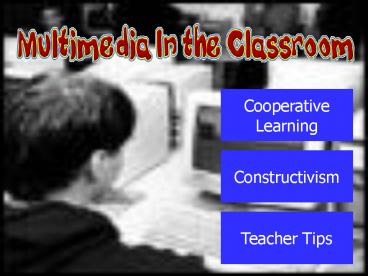Constructivism PowerPoint PPT Presentation
1 / 12
Title: Constructivism
1
Cooperative Learning
Constructivism
Teacher Tips
2
Constructivismcreated byKristen Lednum
What is constructivism?
The Constructivist Classroom
Teacher vs. Student Roles
Pros and Cons
Traditional vs. Constructivist Classroom
Constructivism and Multimedia
3
What is constructivism?
- Probably the most generally accepted principle
of constructivism is that what a person knows is
not passively received, but actively assembled by
the learner (Jonasen, 1991). A second
principle is that, the role of learning is to
help the individual operate within his or her
personal world (Grabe Grabe, 2001).
Constructivism A Concept Map http//www.uib.no/P
eople/sinia/CSCL/HMM_Constructivism.htm
Grabe, M. and Grabe, C. (2001). Integrating
Technology for Meaningful Learning. N.Y
Houghton Mifflin Company.
4
What is constructivism?
Lev Vygotsky
Jean Piaget
Seymour Papert
John Dewey
Click on an expert above to hear their
contribution to constructivism.
Classroom Compass. (1995). Building an
Understanding of Constructivism. Retrieved July
11, 2003 from http//www.sedl.org/scimath/compass/
v01n03/understand.html
5
The Constructivist Classroom
Adapted from What does
constructivism have to do with my classroom?
Disney Learning Partnership. Retrieved July 3,
2003 from http//www.thirteen.org/edonline/concept
2class/month2/index_sub2.html
6
Teacher Roles vs. Student Roles
- to be a facilitator
- to guide
- give cognitive support
- to be open minded
- to assess the learner individually
- takes responsibility for his own learning
- learns new ways to learn
- uses technology to learn
Adapted from Nordoff, Helga (1999).
Constructivism and Technology Enhanced Learning
Retrieved July 3, 2003 from http//hagar.up.ac.za
/catts/learner/1999/nordhoff_hi/iro880/learning/co
nstruc.htm
7
Pros and Cons of Constructivism
- children are actively involved
- concentrates on thinking and understanding
- students create organizing principles that they
can take with them to other learning settings - gives students ownership of what they learn
- students learn to question things
- promotes social and communication skills by
creating a classroom environment that emphasizes
collaboration and exchange of ideas.
- are most successful with children from privileged
backgrounds - tend to produce a "tyranny of the majority," in
which a few students' voices or interpretations
dominate the group's conclusions - constructivists have made themselves
unaccountable for their students' progress - students lag behind in basic skills.
Adapted
from What are the benefits of constructivism?
Disney Learning Partnership Retrieved July 3,
2003 from http//www.thirteen.org/edonline/concep
t2class/month2/index_sub2.html
Adapted
from What are some critical perspectives?
Disney Learning Partnership. Retrieved July 3,
2003 from http//www.thirteen.org/edonline/concep
t2class/month2/index_sub2.html
8
Constructivist Classroom
Traditional Classroom
Adapted from How does this
theory differ from traditional ideas about
teaching and learning? Disney Learning
Partnership. Retrieved July 3, 2003 from
http//www.thirteen.org/edonline/concept2class/mon
th2/index_sub1.html
9
Constructivism and Multimedia in the Classroom
- Technology offers tools of creativity.
- word processing and desktop publishing
- databases and spreadsheets
- digital photography and art applications
- multimedia and web-authoring programs
- Technology offers various forums of
communication. - listservs
- live chats
10
Constructivism and Multimedia In the Classroom
- Technology offers a vast amount of information.
- students can initiate searches
- educational institutions have posted useful
- material in the sciences, mathematics,
literature, and social sciences - current material on major events is immediately
available
11
Credits
Graphics
thumbs up and thumbs down Bridal Information.
Retrieved July 10, 2003 from http//www.bridalinf
ormation.com/thumbs.htm students at computer
NetDay Community Initiatives. Retrieved July 10,
2003 from http//www.netday.org/comm_msdelta.htm
Jean Piaget Adolescent Development. Retrieved
July 12, 2003 from http//www.ncsu.edu/chass/exte
nsion/ci/developmental.html John Dewey Essays
on the Philosophy of John Dewey. Retrieved July
12, 2003 from http//www.ittheory.com/dewey.htm
Lev Vygotsky Davidson Films. Retrieved July
12, 2003 from http//www.davidsonfilms.com/vygfot
02.htm Seymour Papert The Macaroni Fellows.
Retrieved July 16, 2003 from http//www.marconifou
ndation.org/pages/fellows/papert.htm
Main
12
Teacher Tips For Multimedia Projects
- Develop the big idea of the unit.
- Have students interpret the key ideas into their
own terms. - Use open-ended questions.
- Allow students to make decisions or choices.
- Motivate students to incorporate their own
appropriate - creativity.
- Require students to try something new or take
risks - ultimately expanding their knowledge of the
technology - being used.
- Apply knowledge (new and original) to the
product. - Make all group members accountable.
- Develop a tool for assessment (i.e. rubric) and
use it - throughout the project.
- Make the project relevant to students.
Main

